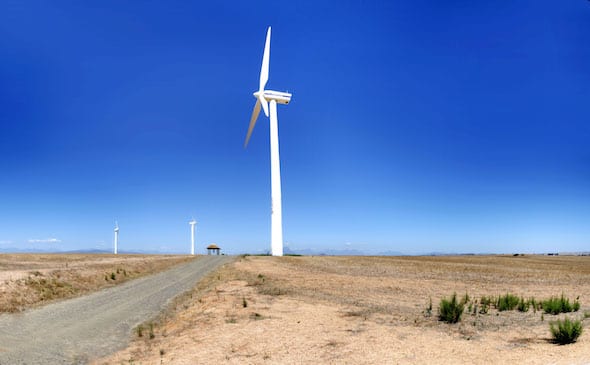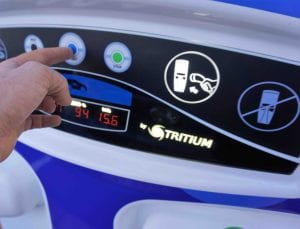South Africa’s state utility, Eskom, has put the brakes on the country’s power procurement programme, putting a question mark over its future auctions for renewable energy. The auctions to date have been heralded as a great success after they attracted at least ZAR 193bn ($13.5bn) of investment and contracted capacity to help stabilise the nation’s power grid.
Since 2011, sub-Saharan Africa’s second-largest economy has held four auctions for renewable power producers, seeing prices for solar PV fall to some of the lowest in the world, at an average tariff of ZAR 786/MWh ($65.52). It is scheduled to hold a fifth auction later this year.
However, Eskom chairman Ben Ngubane said last week that the utility will not sign any further power purchase agreements in the government’s auction programme without further engagement on the issue. Eskom has no say over the price it is obliged to pay the winning projects, and has so far spent some ZAR 207bn ($169m) to connect Rounds 1-3 plants to the grid.
In other African news, Nigeria signed a $1.75bn deal with 14 solar companies to supply more than 1GW of electricity to the nation’s power grid, as is seeks to diversify away from fossil fuel generation. Oil and gas pipelines are increasingly susceptible to attacks by militant groups in the country’s Niger River delta, with gas generation running at less than half of its 6GW installed capacity as a result.
At 4:05 am in Abu Dhabi this morning, the world’s first airplane to fly around the world powered entirely by solar energy touched down after completing a 16-month multi-stage journey of more than 43,000km. Solar Impulse, a pioneering project led by Bertrand Piccard, a hot-air balloon explorer, and Andre Borschberg, a former Swiss Air Force pilot, has developed more efficient solar panels and batteries than those currently found on the market, Borschberg told Bloomberg New Energy Finance in an interview.
Moving further north, lawmakers announced that the UK’s decision to ban subsidies for onshore wind could leave a GBP 3bn ($3.9bn) dent in the Scottish economy. The onshore wind industry supports 21,000 jobs in the country, bringing in more than GBP 1bn of annual investment and supplying as much as 60% of the UK’s onshore wind capacity. The House of Commons Scottish Affairs Committee asked that the UK government improve consultation on any future changes it makes surrounding renewable energy, largely in view of Scotland’s target to generate 100% of its energy from renewables by 2020.
Meanwhile, employment in Britain’s solar industry contracted a third over the past year, with some 12,500 people losing their jobs, as a result of the UK government’s decision to curtail support, according to a report by the Solar Trade Association. The government ended the Renewable Obligation Certificate subsidy programme on 1 April for all solar farms.
In other news, the US government pledged $4.5bn to build electric car charging stations, in a bid to promote consumer acceptance of low-carbon technology. By 2020, the administration aims to complete a coast-to-coast network of fast charging stations, while local governments will be encouraged to buy electric cars for their fleets.
Elon Musk unveiled his long-awaited, second “master plan” on the blog of his company Tesla Motors last week, outlining a vision for how the electric car company will develop into the next decade. Freight trucks and re-imagined buses are “both are in the early stages of development at Tesla and should be ready for unveiling next year,” while development in self-driving technology will allow drivers to “summon [their] Tesla from pretty much anywhere,” Musk said in his blog.
However, “Musk’s latest master plan reads more like a wish list than anything near executable in the medium term, given the company’s balance sheet and current free cash flow,” said an advanced transport analyst at BNEF. Tesla lost $2bn in the last year of operation and will be facing competition from the likes of Proterra and BYD in the realm of electric buses – two incumbents backed by investors including Kleiner Perkins Caufield and Berkshire Hathaway.

Q&A of the week
Mytrah won’t ‘threaten reputation’ bidding too low in India’s wind auctions
Mytrah Energy wants to preserve its reputation for delivering renewable energy projects, which may not be consistent with bidding ever lower prices at auctions. Mytrah will bid in India’s upcoming wind auctions at a price “consistent with its expected returns”, said Bob Smith, head of international business and investor relations at the wind energy developer.
The UK-listed company previously bid in India’s solar auctions at an average price of 5.7 rupees (8 US cents) per K W – ” a level we believed sensible for out business” Smith told Clean Energy and Carbon Brief in an interview. Diversifying into solar reduces cash-flow risk for the company, which has almost 1GW of wind capacity installed in India, he said. The $115m-valued energy provider, which is also considering whether to raise some $400m by listing an infrastructure investment trust, will stick to the same philosophy in all sectors. “We built our business on the basis of delivery” and won’t bid anything that would threaten that reputation, Smith said.
India’s Ministry of New and Renewable Energy unveiled a draft scheme in June to auction 1GW of wind projects in 2016-17— separate to the existing feed-in tariffs. The proposal for competitive bidding will allow “states that are not wind-rich to participate in the wind market;” more evenly distributing the country’s wind resource, Smith said. Grid constraints should not pose a problem – Mytrah has “only seen curtailment where wind resource has been extremely high,” he said.
There is also opportunity to capitalise on the “enormous, fragmented collection of wind sites in high-value locations” in India, via the government’s proposed repowering policy, according to Mytrah. Despite the complexity involved in consolidating these sites, repowering would enable developers to replace older turbines with the more efficient models available today.
Likewise, it is possible to maximise the potential of electrical infrastructure by installing both wind and solar at the same site, Smith said. He “expects a resolution to the tariff problem” of hybrid projects “in the next couple of years.”
Q: What are your thoughts on India’s 1-GW wind auction plans?
A: We’re very much looking forward to it. It’s an opportunity to demonstrate the strength of our business model and ensure we have an advantage in the auctions. In India, renewable energy is produced at the cost of the alternative. People are buying wind and solar because it’s better than fossil fuels — it’s the same price and faster to market.
Q: Are you concerned that competitive tenders may bring tariff levels down too low to make projects profitable, or will the electricity be sold at an average pooled price of all bids?
A: It’s difficult to say what the auction structure will be. We are awaiting the results of the government consultation. The technical details are still not clear.
We participated in the solar auctions, and although some of the tariff levels bid in those auctions were very low, we bid at a level we believed sensible for our business. We built our business on the basis of delivery and didn’t want to bid anything that would threaten that reputation.
We would take the same philosophy with wind. We’ll take part in the wind auction process but will bid a price where we think we can make the returns we expect…
Source: Bloomberg New Energy Finance. Reproduced with permission.










